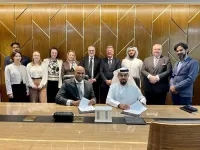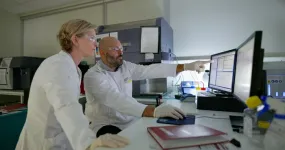(Press-News.org) CLEVELAND–By discovering how zebrafish use their hair cells to detect distant movement, a team of Case Western Reserve scientists may have found a path to help explain human hearing loss.
Even though the tiny water creatures and humans would appear to have nothing in common, the structure and function of the hair cells on zebrafish skin are nearly identical to cochlear hair cells found in the human inner ear.
In addition, both the fish and human cell receptors have a type of protein known as an “ion channel,” which converts the waves that the cells detect into electrical impulses that carry useful information.
However, in humans, those hair cells are encased in the hardest bone in the body and inaccessible when the ear is responding to sound, said Brian McDermott, an associate professor of otolaryngology at the Case Western Reserve (CWRU) School of Medicine.
“So this research—using zebrafish hair cells which are much more accessible—will definitely help inform our understanding of human hearing and deafness,” he said. “We can now say with confidence that fish use their ion channels to escape pursuing predators in ways that are similar to the ways human ears tune to different frequencies.”
Otolaryngology focuses on the ear, nose and throat. McDermott, who led the new research recently published online in the journal Current Biology, also has secondary appointments in biology, genetics and genomes sciences, and neurosciences at the CWRU College of Arts and Sciences and the School of Medicine.
Understanding mechanotransduction
Scientists had already understood how hair cells functioned physiologically for hearing—but less so at the molecular level. The hair cells are made up of a bundle of movement-sensing rods of increasing heights.
Further, McDermott said the finding also advances our understanding of “the long-sought mechanotransduction (Mec) channel” in living creatures. Mec describes the conversion of mechanical stimuli to electrical signals forwarded to the brain.
McDermott said his research team had a true “eureka moment” when, using the CRISPER-Cas9 gene-editing tool, they discovered that groups of hair cells have asymmetry. That unexpected characteristic allows the hair cells to detect movement from the back of the fish with greater sensitivity than the front.
“This shows that fish have hair cells that are actually tuned to sense different water directions,” he said. “In humans, our cochleas have hair cells that are similarly tuned to be able to hear different frequencies.”
That’s why this work could play a role in better understanding hearing—and deafness—in humans, McDermott said.
Contributing authors include CWRU graduate student Kayla Kindig, Assistant Professor of otolaryngology Ruben Stepanyan and National Institutes of Health scientist Katie Kindt.
###
Case Western Reserve University is one of the country's leading private research institutions. Located in Cleveland, we offer a unique combination of forward-thinking educational opportunities in an inspiring cultural setting. Our leading-edge faculty engage in teaching and research in a collaborative, hands-on environment. Our nationally recognized programs include arts and sciences, dental medicine, engineering, law, management, medicine, nursing and social work. About 5,800 undergraduate and 6,300 graduate students comprise our student body. Visit case.edu to see how Case Western Reserve thinks beyond the possible.
END
Hairs that help fish feel–and humans hear
Case Western Reserve University neurobiologist, team advance understanding of how zebrafish use hair cells to detect movement; findings apply to human hearing, balance
2023-04-13
ELSE PRESS RELEASES FROM THIS DATE:
Wildfires and animal biodiversity
2023-04-13
Wildfires. Many see them as purely destructive forces, disasters that blaze through a landscape, charring everything in their paths. But a study published in the journal Ecology Letters reminds us that wildfires are also generative forces, spurring biodiversity in their wakes.
“There’s a fair amount of biodiversity research on fire and plants,” said Max Moritz, a wildfire specialist with UC CooperativeExtension who is based at UC Santa Barbara’s Bren School of Environmental Science & Management, and is the study’s lead author. Research has shown that in ecosystems where fire is a natural and regular occurrence, there ...
New look at climate data shows substantially wetter rain and snow days ahead
2023-04-13
A key source of information underpinning the upcoming National Climate Assessment suggests that heavy precipitation days historically experienced once in a century by Americans could in the future be experienced on several occasions in a lifetime.
Scientists at Scripps Institution of Oceanography at UC San Diego and the Department of Energy’s Lawrence Berkeley National Laboratory (Berkeley Lab) report that extremely intense days of rain or snow will be more frequent by the end of this century than previously thought ...
Manchester graphene spin-out signs $1billion game-changing deal to help tackle global sustainability challenges
2023-04-13
A spin-out company from the graphene innovation ecosystem at The University of Manchester has formed an international partnership that will spearhead an unprecedented scale-up of graphene-based technologies intended “to make a substantial impact on global CO2 emissions”.
UK-based Graphene Innovations Manchester Ltd (GIM), founded by University of Mancheser graduate Dr Vivek Koncherry, has signed a Memorandum of Understanding (MoU) with Quazar Investment Company to create a new company in the UAE. Graphene innovation has "
This agreement - ...
Will ChatGPT replace computational materials scientists?
2023-04-13
“ChatGPT is a very impressive tool,” said paper author Zijian Hong, professor at the School of Materials Science and Engineering, Zhejiang University, China. “As a computational materials scientist, I’m always eager to embrace new tools, in particular, new tools in computer science and AI. Since the born of the new ChatGPT, I’m just wondering whether such a tool can assist us in computational materials science”
Hong explained that for a computational materials task, there are three main steps: building a model or a structure, writing ...
Towards a deeper understanding of turbulence in elastoviscoplastic fluids
2023-04-13
Three-dimensional simulations shed light on how energy dissipates within non-Newtonian fluids (fluids in which viscosity depend on the shear rate.) The result is valuable in the context of disaster forecast and management or industrial production.
Elastoviscoplastic (EVP) fluids like mud, concrete, and lava are a type of non-Newtonian fluid that exhibit both solid and fluid-like behavior depending on the forces they are subjected to (i.e., applied stress). Their flow behavior is more complex than that of Newtonian fluids, such as water and air, which have a constant viscosity. In a recent study, researchers ...
Stop signals reduce dopamine levels and dancing in honeybees
2023-04-13
Researchers from the Xishuangbanna Tropical Botanical Garden (XTBG) of the Chinese Academy of Sciences and the University of California San Diego have revealed that receiving an inhibitory signal (stop signal) associated with negative food conditions can decrease brain dopamine levels in dancing honeybees.
The study was published in Current Biology on April 13.
Dopamine is known as the feel-good neurotransmitter—a chemical that ferries information between neurons. In multiple animals, dopamine is involved in arousal, cognition, and sensitivity to stimuli. It is also associated with seeking and wanting behavior, particularly ...
Health care–associated infections among hospitalized patients with vs without COVID-19
2023-04-13
About The Study: In this analysis of more than 5 million hospitalizations between 2020 and 2022, health care–associated infection (HAI) occurrence among inpatients without COVID-19 was similar to that during 2019 despite additional pressures for infection control and health care professionals. The findings suggest that patients with COVID-19 may be more susceptible to HAIs and may require additional prevention measures.
Authors: Kenneth E. Sands, M.D., M.P.H., of HCA Healthcare in Nashville, is the corresponding author.
To access the embargoed study: Visit our For The Media website at this link https://media.jamanetwork.com/
(doi:10.1001/jamanetworkopen.2023.8059)
Editor’s ...
Risk of new retinal vascular occlusion after mRNA COVID-19 vaccination
2023-04-13
About The Study: The findings of this study including more than 3 million patients receiving the mRNA COVID-19 vaccine suggest that retinal vascular occlusion (RVO) diagnosed acutely after vaccination occurs extremely rarely at rates similar to those of two different historically used vaccinations, the influenza and tetanus, diphtheria, pertussis (Tdap) vaccines. No evidence suggesting an association between the mRNA COVID-19 vaccination and newly diagnosed RVO was found.
Authors: Rishi P. Singh, M.D., of ...
[EMBARGOED] The 2020 election saw fewer people clicking on misinformation websites, Stanford study finds
2023-04-13
In the run-up to the 2020 election, people appear to have become savvier in spotting misinformation online: clicks onto unreliable websites have declined, according to a new Stanford study published April 13 in the journal Nature Human Behaviour. According to prior research, some 44.3 percent of Americans visited websites during the 2016 U.S. election that repeatedly made false or misleading information.
During the 2020 election, Stanford scholars saw that number drop by nearly half to 26.2 percent.
While these findings ...
Curtin researchers map genetic signature of precursor to liver cancer
2023-04-13
Researchers at Curtin University have identified the genetic signature of pre-malignant liver cells, offering potentially significant implications for the almost 3,000 Australians diagnosed with the deadly cancer each year.
The study, published in the prestigious journal Cell Genomics, found that quantifying pre-malignant liver cells in patients with liver disease could help determine their future risk of developing liver cancer.
First author Dr Rodrigo Carlessi, from the Curtin Medical School and the Curtin Health Innovation Research Institute, said the discovery had the potential to save lives by changing how chronic liver disease patients ...
LAST 30 PRESS RELEASES:
Sleeping in on weekends may help boost teens’ mental health
Study: Teens use cellphones for an hour a day at school
After more than two years of war, Palestinian children are hungry, denied education and “like the living dead”
The untold story of life with Prader-Willi syndrome - according to the siblings who live it
How the parasite that ‘gave up sex’ found more hosts – and why its victory won’t last
When is it time to jump? The boiling frog problem of AI use in physics education
Twitter data reveals partisan divide in understanding why pollen season's getting worse
AI is quick but risky for updating old software
Revolutionizing biosecurity: new multi-omics framework to transform invasive species management
From ancient herb to modern medicine: new review unveils the multi-targeted healing potential of Borago officinalis
Building a global scientific community: Biological Diversity Journal announces dual recruitment of Editorial Board and Youth Editorial Board members
Microbes that break down antibiotics help protect ecosystems under drug pollution
Smart biochar that remembers pollutants offers a new way to clean water and recycle biomass
Rice genes matter more than domestication in shaping plant microbiomes
Ticking time bomb: Some farmers report as many as 70 tick encounters over a 6-month period
Turning garden and crop waste into plastics
Scientists discover ‘platypus galaxies’ in the early universe
Seeing thyroid cancer in a new light: when AI meets label-free imaging in the operating room
Neutrophil-to-lymphocyte ratio may aid risk stratification in depressive disorder
2026 Seismological Society of America Annual Meeting
AI-powered ECG analysis offers promising path for early detection of chronic obstructive pulmonary disease, says Mount Sinai researchers
GIMM uncovers flaws in lab-grown heart cells and paves the way for improved treatments
Cracking the evolutionary code of sleep
Medications could help the aging brain cope with surgery, memory impairment
Back pain linked to worse sleep years later in men over 65, according to study
CDC urges ‘shared decision-making’ on some childhood vaccines; many unclear about what that means
New research finds that an ‘equal treatment’ approach to economic opportunity advertising can backfire
Researchers create shape-shifting, self-navigating microparticles
Science army mobilizes to map US soil microbiome
Researchers develop new tools to turn grain crops into biosensors
[Press-News.org] Hairs that help fish feel–and humans hearCase Western Reserve University neurobiologist, team advance understanding of how zebrafish use hair cells to detect movement; findings apply to human hearing, balance








